People who convey voices from the sea
People who convey voices from the sea
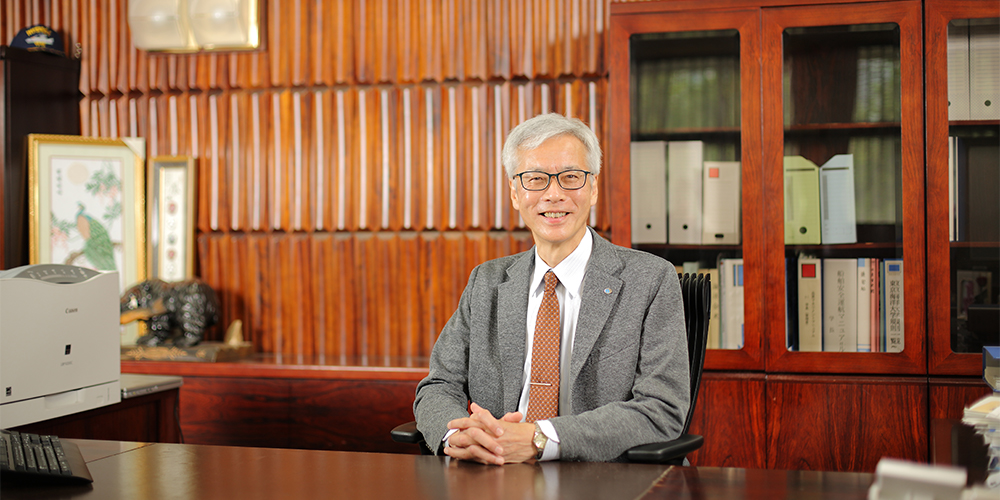
When the wave is received from the front and the conditions are met,
A great excitement arises, and you feel like you want to accomplish something
President Toshio Iseki
When the wave is received from the front and the conditions are met,
A great impression arises,
feel like accomplishing something
President Toshio Iseki
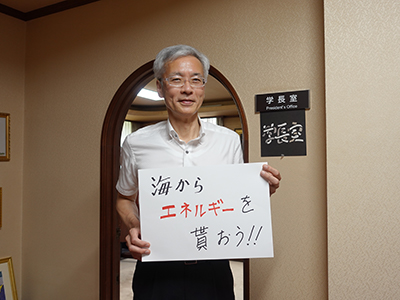
Biography
Toshio Iseki(Toshio Iseki)
| June 1984 | Graduated from Department of Shipbuilding, Faculty of Engineering, Kyushu University |
| June 1989 | Withdrawal from the doctoral program at Kyushu University |
| June 1989 | Lecturer, Faculty of Merchant Marine, Tokyo University of Mercantile Marine |
| June 1989 | Doctor of Engineering (Kyushu University) |
| June 1990 | Associate Professor, Department of Merchant Marine, Tokyo University of Mercantile Marine |
| June 1991 | Inland Researcher, Ministry of Education (Department of Naval Architecture and Ocean Engineering, Faculty of Engineering, University of Tokyo) |
| June 1995 | Research Fellow of the Ministry of Education (University of Glasgow, United Kingdom) |
| June 2003 | Associate Professor, Faculty of Ocean Engineering, Tokyo University of Marine Science and Technology (university integration) |
| June 2006 | Professor, Faculty of Ocean Engineering, Tokyo University of Marine Science and Technology |
| June 2016 | Dean, Graduate School of Marine Science and Technology, Tokyo University of Marine Science and Technology |
| June 2020 | Dean of Tokyo University of Marine Science and Technology, Director of the Library |
| June 2021 | President of Tokyo University of Marine Science and Technology |
- Q What kind of research did you do when you were a student?
↓
- I was developing a computational program for computational fluid dynamics.The subject was the fluid in the spherical tank of a liquefied natural gas (LNG) carrier, and I was analyzing how it behaves due to the hull rolling in waves.
I'm sure you've all seen a large ship with multiple spherical tanks. LNG needs to be transported after being liquefied at an extremely low temperature of minus 162 degrees.For that reason, the tank is filled with insulation to prevent the temperature from rising, but if the tank shakes during transportation, the LNG hits the tank wall, and there is a risk that the insulation will break due to the large impact. there is.
Therefore, an analysis was conducted to determine how much LNG would be violent in the tank under what kind of sea conditions.At that time, the general-purpose fluid analysis software required for analysis was not available on the market, so I thoroughly deciphered the programs that had been handed down in the laboratory, read papers and textbooks, and completed a program that matched my research theme. I was allowed to.When I was a student, the large-scale computers had very low performance compared to today, and the challenge was how to write efficient programs.Looking back on it now, at that time I was only looking at computers and didn't see much of the actual phenomenon.If I were in front of you when I was a student, I would probably give you a stern lecture on basic research attitudes.
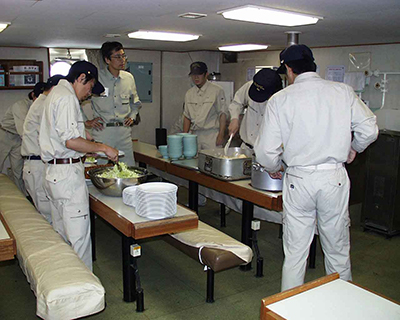
Preparing dinner during the Shiojimaru practice (President Iseki is in the back left)
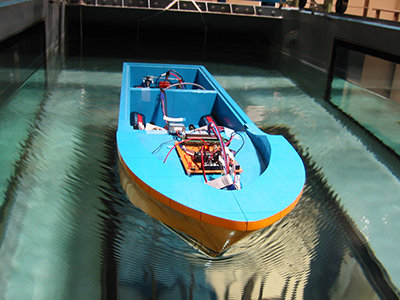
Research scene of President Iseki.Research is conducted using actual ship measurement data and model test data. - Q What inspired you to do this research?Please tell us how you became a researcher.Please tell us about the episodes that you fell in love with.
↓
- Actually, when I was in high school, my first choice for college entrance exams was aeronautical engineering, and my second choice was shipbuilding.During the school festival with my classmates in high school, I studied fluid mechanics books at the prefectural library and designed and built a manned biplane glider.Of course, it was too heavy to float at all with a man, but that is what sparked my interest in fluid dynamics.
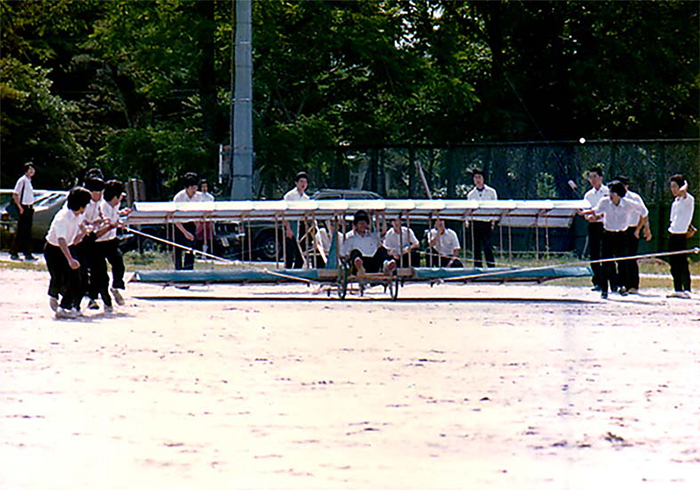
I wasn't good enough for university entrance exams, so I entered the Department of Shipbuilding, my second choice.At first, I was discouraged, but during the summer vacation of my third year of undergraduate school, I took part in a factory training program, which changed my mind significantly.Bulk carrier under construction between welding and gas cutting training■When I saw it up close, I was overwhelmed by its sheer size, and decided to make boat building my life's work.
* Bulk carrier: A vessel that specializes in transporting bulk cargo (unpacked cargo, iron ore, etc.)
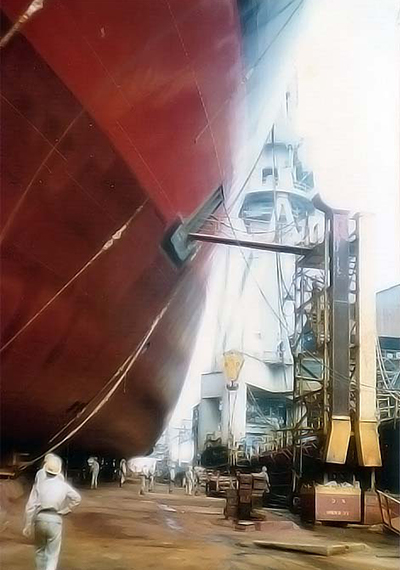
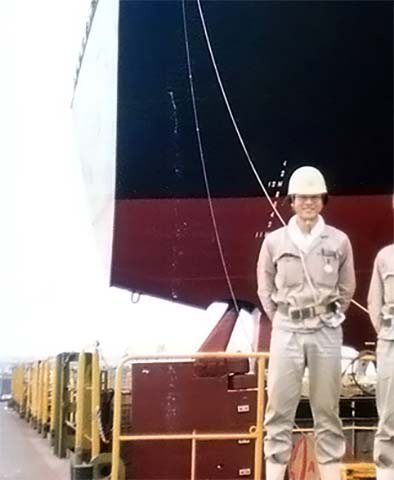
Then, in my fourth year of undergraduate school, I entered a ship design laboratory.At that time, the research theme presented to graduation thesis students used either probability statistics or computational fluid dynamics.I love programming, so I chose the subject of Computational Fluid Dynamics without hesitation and fell in love with displaying analysis results in 4D graphics.I think I fell in love with programming because when I was in my second year of undergraduate school, I bought an early computer, the NEC PC3, with the money I earned from a part-time job.At that time, only a few enthusiasts bought computers, but when I saw elementary school students playing with computers on the TV news, I thought that we should not be left behind.While manually typing game programs published in computer magazines, I gradually became able to write my own programs.
An interesting memory was making a program that reproduced a board game that required probabilistic decisions on a computer and made the computer play against humans.When I had a friend in the lab play against me, my program was quite strong, but when I explained the algorithm, the situation changed completely and I remember being beaten.For the first time, I experienced programming by simulating human thinking, and while enjoying it, I realized that it would take a tremendous amount of effort to make it stronger.
Also, in the drafting class, we used to calculate the amount of displacement using a large paper calculation table, but now we can reproduce the calculation table in the program and immediately calculate the amount of displacement and the center of buoyancy.After that, in my first year of the master's course, I developed a program to calculate the stability of a ship that has listed.Since it was necessary to express the hull shape smoothly, I looked up cubic spline interpolation in a book and incorporated it into the calculation program.The drafting teacher also confirmed that the calculation results were correct, and senior graduate students also used the program.The program I made was recognized, and the fact that I was useful to people led to an increase in motivation. - Q Of all the research you have conducted as a researcher, which one left a particularly strong impression on you?
↓
- In mathematics, there is the Mathieu equation, and it is known that when certain conditions are met, the solution becomes unstable and diverges.This seemingly purely mathematical phenomenon actually exists in the hull as well.It is called parametric rolling, but it is a dangerous phenomenon in which large-amplitude rolling occurs under certain conditions when waves are received from the bow direction instead of transverse waves.The occurrence of this phenomenon must be avoided for safe navigation of ships, but it can be seen as a very beneficial phenomenon from the viewpoint of wave power generation.Wave power generation equipment, which is a renewable energy recovery device, has a type that generates floating body oscillation by waves and converts the kinetic energy into electrical energy.By intentionally generating and maintaining this Mathieu-type instability, it may be possible to recover renewable energy with high efficiency.In addition, for example, when a power generator is installed on the hull, it is possible to reduce the shaking of the ship by recovering the kinetic energy.If the swaying of the boat is reduced, the ride will be more comfortable.In addition, considering efficient energy recovery from waves and equipment maintenance, we think that it is better to generate power on the breakwater.It left an impression on me that I conducted this kind of research, mainly model experiments, together with international students in the doctoral course.
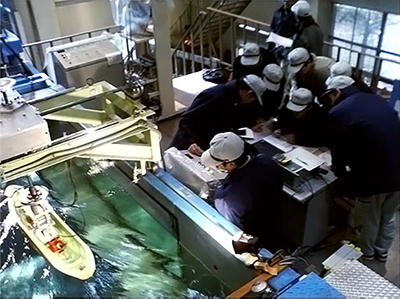
Experimental scene in a circulating water tank
- Q: How many of the SDGs have your research to date been related to?How will your research help society?
↓
- It has to do with number 7, “Energy”.Offshore wind power generation is currently considered to be the most promising source of natural energy on the ocean, but wave power generation, tidal/ocean current power generation, and ocean thermal energy conversion power generation are also considered promising.Furthermore, there are three types of wave power generation: the oscillating water column type, the oscillating float type, and the wave overtopping type. I suspect it is.The theory of the research I mentioned in the previous question can be applied to all rocking float type wave power generation equipment, so I would be happy if it could be of some help in achieving SDGs No. XNUMX.
To be honest, I am not very familiar with the keywords of renewable energy and sustainability as a researcher, as they are concepts that came up at the end of my research results. It is a very important way of thinking as a direction, and I would like you to share the importance of it within the university and work on activities.At first glance, it seems difficult for the Faculty of Marine Engineering to find goals that match the SDGs, but I think research on ship collision prevention, for example, will lead to SDGs in that collision accidents lead to marine pollution. . - Q What kind of university do you want Ocean University to be in 2030 and beyond?
↓
- I would like the university to be a place where various people, from various perspectives, are conducting various studies on the ocean.When I was a high school student, I attended a lecture by Mr. Eisaburo Nishibori, who participated in the Antarctic Expedition.At that time, he said, ``There are convex lens type people who concentrate on one thing, and concave lens type people who work with a wide field of view.''There are many kinds of people in the world.Convex lens types and concave lens types, serious people and optimistic people, people who are in a hurry and people who go slowly. I think I wantEven in a crisis, if everyone has the same way of thinking, it will be a total collapse.

- Q Looking ahead to 2030, what kind of things do you want incoming students to learn and experience at Ocean University?
↓
- I think it would be great if you could encounter something new and experience the moment when the direction you want to go and the direction you want to go is perfectly decided.It's not Matthew's equation, but when you receive the waves head-on and the conditions are met, you may feel a great excitement and want to achieve something.Also, even if you think that you are a scary and strict teacher at first glance, you may actually be an interesting teacher.If you don't get caught up in superficial things and dive into your bosom, you'll find unexpected encounters.And it's interesting that such an unexpected encounter suddenly appears.By all means, please actively seek encounters at Ocean University and have various experiences.
- Q Is there anything you would like to say to high school students who are wondering whether to take the Tokyo University of Marine Science and Technology?
↓
- The feature of Tokyo University of Marine Science and Technology is practical learning.Although it is a small university, it is fully equipped with training ships, a field center, and experimental facilities on campus.The fields we deal with are also wide-ranging.Therefore, it may be easier for you to find an area that interests you.Another feature is that the distance between teachers and students is close.If there is something that bothers you about this university compared to other universities, or something that bothers you, please seriously consider taking the entrance exam.The subject of education and research at our university is the vast ocean surrounding the earth.I believe that you can always find the value of your life.
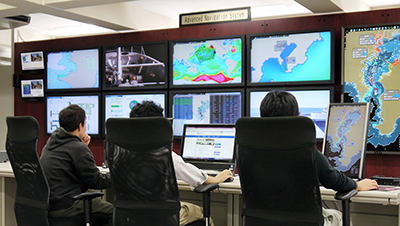
Advanced navigation system
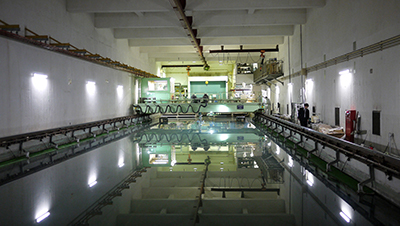
Vessel operation performance test tank







